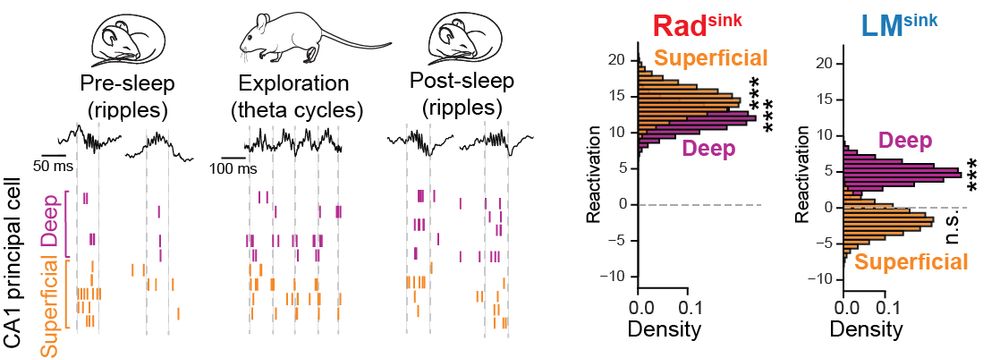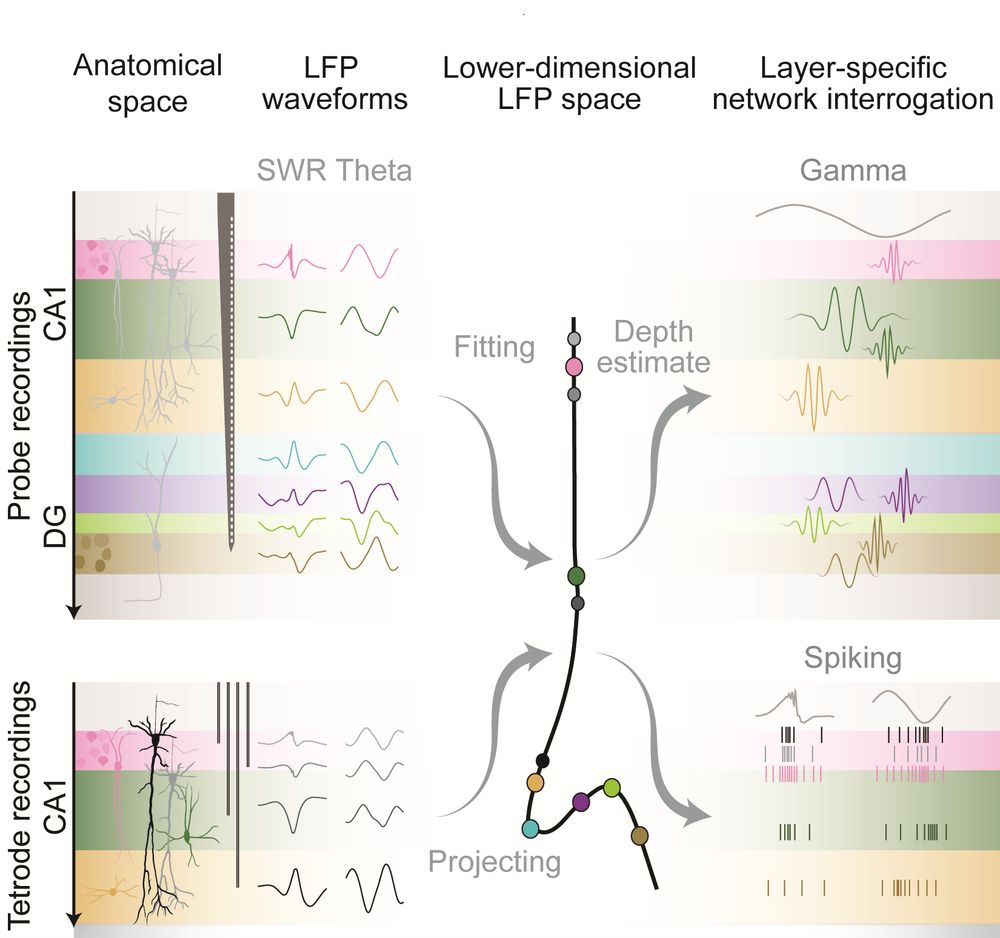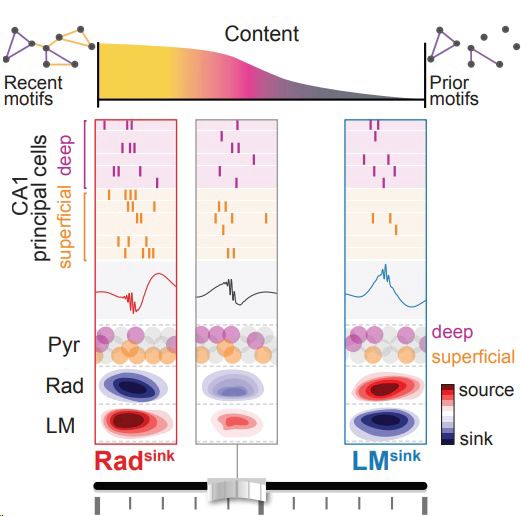If you’re at #SfN25 in San Diego, come check out my poster (Board KK3) today, 3–5 pm!
It highlights findings from our recent Neuron paper on the diversity of hippocampal ripples:
🔗 www.cell.com/neuron/fullt...
Come by to discuss ripples or just to say hi 😊
15.11.2025 18:38 — 👍 3 🔁 0 💬 0 📌 0
Makes sense about SfN!
Yeah very interesting things might be going on from CA1 to PFC ! Very cool discussion :)
07.10.2025 10:15 — 👍 1 🔁 0 💬 0 📌 0
Yes these are all extremely interesting points to think about. I mean based on the link between deep cells and PFC shown by Harvey (and cool stuff in PFC by El Gaby 2024), I think you might be correct 😊 not sure if you will be at SfN but happy to chat more about it then!
04.10.2025 12:56 — 👍 0 🔁 0 💬 1 📌 0
In line with this, we show that superficial cells are more biased to recent motifs.
Howevere, throughout post-sleep, LMsink prior motifs gradually shift to recent ones, mainly driven by deep cells (Fig. S7). We suggest in the discussion that this may involve hippocampal–entorhinal loop dynamics.
03.10.2025 13:15 — 👍 3 🔁 0 💬 1 📌 0
Thank you, James, for the kind words. I see your point. Within one context, deep cells are often more “plastic,” anchoring to local cues, while superficial cells are more rigid, tied to global cues (www.sciencedirect.com/science/arti...)
03.10.2025 13:08 — 👍 3 🔁 0 💬 1 📌 0
Hope this answers your question, and happy to chat more at SfN this year? :)
03.10.2025 13:07 — 👍 1 🔁 0 💬 1 📌 0
That is a very exciting point! We did not directly test how the distance between prior and recent patterns shapes the dynamics, but we kinda did indirectly: our recent-to-prior balance measure quantifies, for each ripple, how strongly the motif aligns with prior vs. recent patterns.
03.10.2025 13:06 — 👍 0 🔁 0 💬 1 📌 0
We found that only during LMsink ripples the prior patterns gradually drift toward recent ones (Fig. 7D–F). At the same time, these motifs also reappear with additional neurons in Radsink ripples; so we concluded that Radsink motifs are composite versions of the prior motifs expressed in LMsink.
03.10.2025 13:02 — 👍 0 🔁 0 💬 1 📌 0
Thanks, Ben! We did not specifically look at sequential replay but at coactivity patterns in ripples and how they related to pre-sleep (prior) vs. exploration (recent). (Replying below to your other points due to characters limit 😉)
03.10.2025 13:00 — 👍 0 🔁 0 💬 1 📌 0
This was the core of my PhD project and I feel very fortunate to have carried it out in such a great lab, learning immensely from
@vitorlds.bsky.social and David. I also thank the reviewers, whose input greatly improved the paper.
(11/11)
02.10.2025 15:50 — 👍 1 🔁 0 💬 0 📌 0

Hippocampal ripple diversity organizes neuronal reactivation dynamics in the offline brain
Hippocampal ripples are highly synchronized neuronal population patterns reactivating past waking experiences in the offline brain. Whether the level,…
We propose that ripple diversity tunes the activity, structure, and neuronal content of population patterns, supporting two parallel channels: one consolidating recent experience, the other updating prior memory.
Check the paper out: sciencedirect.com/science/arti...
(10/11)
02.10.2025 15:50 — 👍 3 🔁 0 💬 1 📌 0

In sum, Radsink ripple coactivity was stably aligned with recent waking motifs throughout post-exploration sleep. LMsink ripple coactivity initially reflected prior motifs but gradually drifted toward recent motifs, eventually reaching levels comparable to Radsink ripples.
(9/11)
02.10.2025 15:49 — 👍 1 🔁 0 💬 1 📌 0

Radsink ripples consistently aligned with recently acquired motifs and stayed stable throughout sleep. LMsink ripples expressed prior motifs but gradually disengaged from them, drifting toward recent motifs.
(8/11)
02.10.2025 15:49 — 👍 1 🔁 0 💬 1 📌 0

Looking at CA1 sublayers, both deep and superficial principal cells reactivated their waking theta coactivity during Radsink ripples. In contrast, during LMsink ripples only deep CA1 cells showed significant reactivation.
(7/11)
02.10.2025 15:49 — 👍 2 🔁 0 💬 1 📌 0

We then asked how ripple types structure coactivity motifs in CA1. LMsink ripples contained sparse, low dimensional motifs that acted as a core. During Radsink ripples these motifs reappeared with additional neurons, forming denser, composite patterns.
(6/11)
02.10.2025 15:48 — 👍 1 🔁 0 💬 1 📌 0

CA1 and CA3 principal cells fired at higher rates during Radsink ripples than during LMsink ripples. The timing of their responses also differed across types and aligned with current sinks in radiatum, lacunosum moleculare, and DG molecular layers.
(5/11)
02.10.2025 15:48 — 👍 1 🔁 0 💬 1 📌 0

Next, we asked how ripple types engage neuronal populations. Using tetrode recordings from CA1 and CA3, we classified ripple types directly from LFP traces with our open source tool. The code is available here; feel free to check it out and use it in your own work:
🔗 github.com/mcastelli98/...
02.10.2025 15:47 — 👍 2 🔁 0 💬 1 📌 0

To relate ripple types to sleep dynamics, we examined their distribution across cortical up and down states, inferred from DG activity. The proportion of LMsink ripples was higher in up states, suggesting cortical inputs bias ripple profiles.
(3/11)
02.10.2025 15:47 — 👍 1 🔁 0 💬 1 📌 0

To look at the currents driving ripples, we used current source density (CSD). The average showed the expected sink in CA1 radiatum, but individual ripples differed. We consistently found two types, Radsink and LMsink, differing in frequency and waveform.
(2/11)
02.10.2025 15:46 — 👍 3 🔁 0 💬 1 📌 0
Hippocampal ripples are brief, synchronous network events during sleep and rest that are thought to support memory reactivation. We often associate them with sharp-waves from CA3 inputs to CA1 stratum radiatum… but it turns out things are not that simple.
(1/11)
02.10.2025 15:46 — 👍 2 🔁 0 💬 1 📌 0

I’m pleased to share our new paper, “Hippocampal ripple diversity organizes neuronal reactivation dynamics in the offline brain”, out in @cp-neuron.bsky.social !
With @vitorlds.bsky.social and David Dupret, we show that diversity in ripple current profiles shapes reactivation dynamics
02.10.2025 15:46 — 👍 71 🔁 28 💬 4 📌 1
Impressive work congratulations!!
Amazing figures 🙌🏻
02.07.2025 08:51 — 👍 1 🔁 0 💬 1 📌 0

I'm pleased to share our new work, “Spatio-temporal organization of network activity patterns in the hippocampus”, out in @cp-cellreports.bsky.social !
With Demi Brizee & David Dupret, we track how oscillations and spiking behaviour map onto hippocampal layers using an LFP-based embedding.
(1/13)
05.06.2025 17:08 — 👍 51 🔁 23 💬 1 📌 2
Very happy you found this exciting! 😃
19.03.2025 21:01 — 👍 1 🔁 0 💬 1 📌 0

Check out my preprint on hippocampal ripple diversity, with @vitorlds.bsky.social and David Dupret at the MRC BNDU, where we reveal that distinct CA1 laminar profiles of ripples are associated with different reactivation dynamics: www.biorxiv.org/content/10.1...
19.03.2025 20:57 — 👍 33 🔁 9 💬 0 📌 0
PhD student in the Moser lab. Spatial cognition, grid cells, population dynamics, high-density ephys. MD from 🇳🇴
PhD candidate in the Moser Group @KISNeuro | Experimentalist at heart but with some computational interests. Recoding many cells in the entorhinal cortex and hippocampus. Mainly looking at (somewhat) slow population-level dynamics | she/her.
Neuroscientist investigating neuronal bases of reward and learning. Associate Prof at Oxford University. www.laklab.org
Neuroscientist. Humboldtian. Postdoc at the Cognition and Emotion research group, at the Leibniz Institute for Neurobiology - Magdeburg. RT not endorsement. Opinions here solely my own. 🏳️🌈🇧🇷
PhD, Engineer and Neuroscientist, Former at MGH/Harvard | Human intraoperative Neuropixels recordings | Neurotech solutions with clinical perspectives | Boston 🇺🇸 / Budapest 🇭🇺
PhD student in Lak Lab & lecturer @ the University of Oxford. Using multiphoton optogenetics and Neuropixels simultaneously to study how perceptual activity propagates through the brain.
Freelance 3D animation. DM for a quote
Computational Neuroscience Research Scientist @UCSF Frank Lab
https://www.edenovellis.com/
https://github.com/edeno
At the junction of rationality and hypocrisy
For legal purposes, the views expressed here aren't mine.
spatial and abstract navigation @cimecunitrento.bsky.social
Prev: iitgn
Website: atrighosh.github.io
Neuroscientist at the Sainsbury Wellcome Centre (UCL, London) in the labs of Tom Mrsic-Flogel and Tim Behrens
PhD candidate in Clinical Neurosciences at the University of Oxford
Neuron publishes ground-breaking research papers, reviews & commentary across neuroscience and is a premier intellectual forum for the neuroscience community.
https://www.cell.com/neuron/home
Oxford Postdoc in the Staresina Lab | Sleep | Memory | Human Olfaction & Single Neurons
Postdoc Max Planck Institute for Human Cognitive and Brain Sciences.
Neuroscientist using electrophysiology to understand cognitive flexibility, the ACC, and hippocampus. It's all oscillations and vibes.
@UNLV
Neurobiologist interested in spatial cognition and navigation
Research director at INSERM
Team leader "Neuronal mechanisms of spatial cognition" at INMED in Marseille
MD/PhD neuroscientist/psychiatrist. Decision-making, addiction, multi-region ephys and imaging in vivo, novel optical methods for spatial transcriptomics https://sjulsonlab.org
Systems neuroscientist @NCMM (university of Oslo) interested in sleep, cognitive development and learning/memory
Boccaralab.com
MD-PhD Student
Neuroscience PhD candidate - College de France - ZugaroLab - http://zugarolab.net.
Work on the hippocampus, spatial navigation and memory.
Systems neuroscientist. Assistant Professor at
Cornell. Studying the computational and circuit mechanisms of learning, memory and natural behaviors in rodents












